
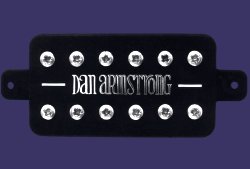
|
The Dan Armstrong 'London' series guitars and basses employ pickups that are a double-coil humbucker design pickup that
features adjustable pole pieces on both coils as can be seen here on the guitar pickup. Although wired as humbuckers
from the factory, they feature multi-wire capability for other wiring options. These pickups are a low impedance design
that came equipped with impedance matching transformers to allow them to plug into conventional amplifiers. Photo courtesy of Craig Buzzart.
|
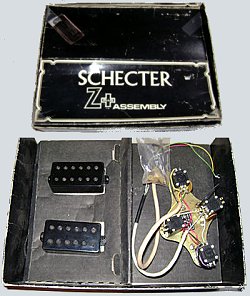
|
When Mutron closed its doors in the late 1970's Mike Biegle of Biegle Labs introduced
Dan Armstrong to Shel Horlick of Schecter Together
they decided to market a new type of pickups called the Z+
The Z+ pickup was designed by Kent that Dan loved. It has a sound very distinct from other humbuckers. After Dan took it to Schecter
Kent and Dan disagreed on how to proceed with the project. Soon after this Dan returned to the US to work on other projects.
These pickups were encased in a translucent green epoxy and eventually produced in an all solid black cast with 12 black allen screw
type pole pieces. Seen at left are a pair of Z Plus pickups that came bundled in a package which was sold as an entire wiring assembly.
To the right of the pickups a brass grounding plate holds volume & tone pots as well as wiring for multiple switching possibilities.
|
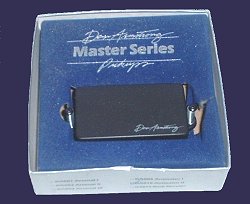
|
Later, as the 80's progressed onward, Dan began making his Master Series pickups which, like the Z-Plus were produced
in a solid black color, but unlike the Z-Plus line, these pickups employed matching black covers that featured Dan's name in the lower corner.
|
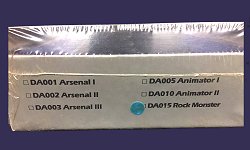
|
These pickups were known as the DA001, DA002, & DA003 Arsenal pickups, as well as the DA005,
DA010 Animator and of course, the ever popular DA015 Rock Monster pickup.
|
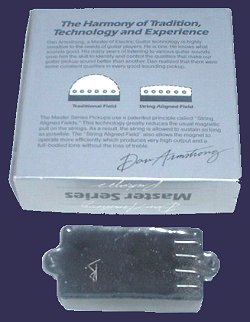
|
These pickups feature a patented principle called 'String Aligned Fields' which, according to literature greatly
reduces the usual magnetic pull on the strings. As a result, the string is allowed to sustain as long as possible.
The string aligned field also allows the magnet to operate more efficiently which produces very high output and a
fullbodied tone without the loss of any treble.
These
pickups are reminiscent of his earlier pickups used on the Ampeg acrylic instruments, in that they are a fully enclosed
unit only unlike the earlier pickups these do not have the female banana plugs. Instead, they have solid coil leads
that protrude from the bottom side of the pickup and allow a myrid different wiring combinations.
Seen here the pickup is shown upside-down and one can see the 4 coil leads protruding from the pickup allowing for
a mulitude of wiring combinations. Notice the letter 'B' scratched into the bottom of the pickup - no doubt making
this the bridge pickup in the last guitar it was in.
|
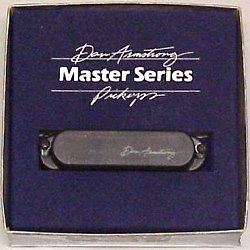
|
Single coil versions were also available, as well as popular for at about the same point in time Dan was enjoying
great success with a wiring scheme for Fender Stratocaster guitars called the Dan Armstrong Super Strat.
These single coil pickups, like the aforementioned humbucking pickups were all marketed through St. Louis Music who
had acquired Ampeg at the time.
|
When Westone contracted Dan to create his Signature Series guitars, he developed a new, revolutionary type of pickup for
what would become his Signature I guitar. Known as the Maxi, it is a massive 3-coil humbucker, meant for the bridge position of the guitar.
Molded the same way, with the black plastic cover, the differences are within, as one could utilize several different coil combinations along with
switching capabilities to achieve a wide variety of sounds.
available.
On the right, and seen from the underside, lead wires can be seen soldered to three pins per side that
make up the three single coil pickups. This pickup, along with another, the Mini which is a miniture
humbucking pickup specifically meant for the neck position can be seen at upper left. These were sold through St. Louis Music - who had aquired not
only Ampeg, but also Westone.
menu
All names and images are TMand © Dan Armstrong / Ampeg. All rights reserved.
|
| |

